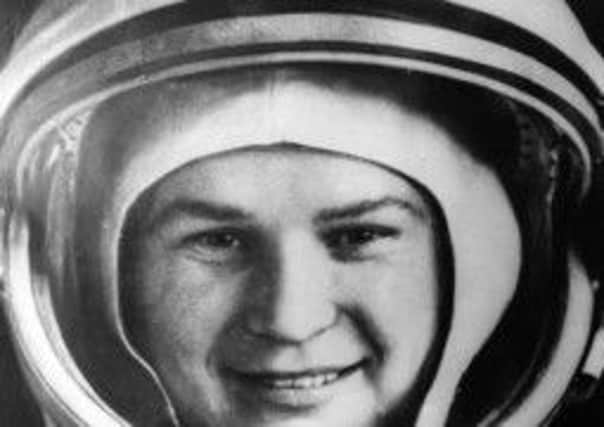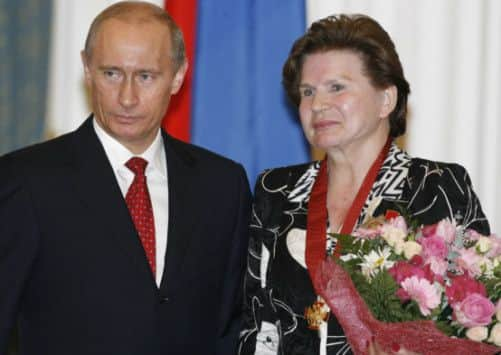Valentina Tereshkova, the first woman in space


FIFTY years ago today, on the steppes of Kazakhstan, a cosmonaut dressed in a red space suit and white helmet nervously ascended a lift to the top of a gleaming rocket, to be strapped into a small capsule by white-suited technicians.
It was the early years of the space race, and similar scenes had already happened five times at Russia’s secretive Baikonur Cosmodrome, and also across the Atlantic at the Florida launch site of their American rivals.
Advertisement
Hide AdAdvertisement
Hide AdThis time, however, the person about to become the 12th human being to enter the perilous environment of space was different from the ranks of ace military jet pilots who had led the way. This cosmonaut was a civilian, and her name was Valentina Tereshkova. She was about to become the first woman in space.


Two hours later, after technical checks, the Vostok rocket rose off the launch pad on a tower of flames and disappeared into the eastern sky as a bright speck of light. Seated at the nose, Tereshkova remained calm as the pressure mounted, pressing her into her seat so that she could hardly breathe. She felt the massive rocket “shaking like a thin tree in the wind”.
In a few minutes of flight the craft reached orbital velocity of 17,000 miles per hour, the last stage dropped away, and the Vostok 6 spacecraft sailed silently into the black void. Tereshkova looked out the porthole and saw the delicate blue strip of the Earth’s curved horizon and the spectacular colours of the continents 100 miles below. Her pencil and logbook floated in front of her helmet.
“Ya Chaika, ya Chaika!” she called to Earth, announcing her call sign, “I am Seagull!” As the name Valentina Tereshkova was broadcast around the world, the anonymous factory worker became one of the most famous women in history.
I first met Valentina 20 years ago in Edinburgh with her friend Lady Antonella Lothian and wartime hero Sir Fitzroy MacLean. Tony Lothian, as she preferred to be known, had written a book on the cosmonaut, whom she befriended at a Woman of the Year Lunch in London.
They made for an unlikely trio. Lady Tony was the aristocratic chatelaine of the Lothian house in Roxburghshire. A strident Roman Catholic feminist, she wore a black eye-patch after losing an eye through cancer, stating: “All I need now is the parrot.”
During the war, Sir Fitzroy had been a spy in Soviet Central Asia and infiltrated German-occupied Yugoslavia with Tito’s partisans. Allegedly the inspiration for Ian Fleming’s James Bond, he later became a Unionist MP.
Tereshkova’s outlook could hardly be more different – she was a committed communist and atheist, and after her spaceflight had gone into politics as a Member of the Supreme Soviet. But they got on exceptionally well and their friendship was genuinely close.
Advertisement
Hide AdAdvertisement
Hide AdTereshkova’s background was also in stark contrast to that of Lady Tony and Sir Fitzroy. She was born in a wooden hut in the rustic village of Maslennikovo, where her father Vladimir was a tractor driver and a gifted accordion player. But the young “Valya” hardly knew him as he was killed in a tank battle early in the war. Her mother Yelena, a woman of remarkable strength and a lifelong guiding light to her daughter, brought her up with her sister and brother. Two other siblings died at birth.
While educating herself through correspondence courses, Tereshkova had been a machinist in a textile factory, and became an accomplished parachutist at her local aero club. Excited by the 1961 space flight of Yuri Gagarin, Tereshkova was sure women would soon follow and wrote to the Supreme Soviet offering her services.
She had the right qualities, not least being under the 5 feet 7 inches height necessary to fit into the capsule. And although Tereshkova was not a pilot, her parachuting skills and impressive record of 163 jumps opened the door to space – the Vostok spaceship made a very hard landing, and the occupant had to eject and land separately by parachute to avoid injury.
As a trusted member of Komsomol, the young communists’ league, Tereshkova also had the necessary ideological qualifications. Soon she was selected for training with four other women and sworn to secrecy. Finally, just 12 days before the launch date, Tereshkova was chosen for the historic mission.
After the launch, despite her initial euphoria and the Radio Moscow broadcasts which declared all was going well, Valentina became temporarily ill from the unaccustomed weightlessness. Many space travellers suffer from these feelings of nausea and vertigo. She dozed off and did not respond to radio calls.
Another Russian cosmonaut, Valery Bykovsky, was already in space on Vostok 5, and he managed to raise her on his radio. The two craft approached within three miles of one another in joint flight.
After three days in space, Vostok 6 plunged through a flaming atmospheric re-entry and landed safely in a wheat field in the Urals. Tereshkova had endured twice the duration of the longest American spaceflight to date – by a man, course.
On her return to Earth, she was romantically linked with the only bachelor in the space programme, Andriyan Nikolayev. They were married later that year, and Soviet premier Nikita Khrushchev gave the bride away.
Advertisement
Hide AdAdvertisement
Hide AdThe couple’s daughter Yelena attracted some medical interest because she was the first child born to parents who had both flown in space. Yelena was completely healthy, and went on to become a medical doctor.
Tereshkova told Tony Lothian that her marriage ended in 1977: “Real life breaks many illusions. Perhaps women are too romantic, too emotional? But if we were not, life would be pale and dull.” She finally found happiness in her second marriage to a surgeon, but is now a widow.
A further 19 years passed before Tereshkova’s successor Svetlana Savitskaya became the second woman in space, followed a year later by the first American, Sally Ride, in 1983. Today, 57 women have travelled into orbit, including Britain’s first astronaut, Helen Sharman. But Tereshkova remains the only woman to have flown solo.
This weekend the latest female astronaut, Wang Yaping, settles into her new home in a Chinese orbital station 200 miles above the earth. She can reflect that her route to space was pioneered by that young curly-haired Russian factory worker 50 years ago today. «